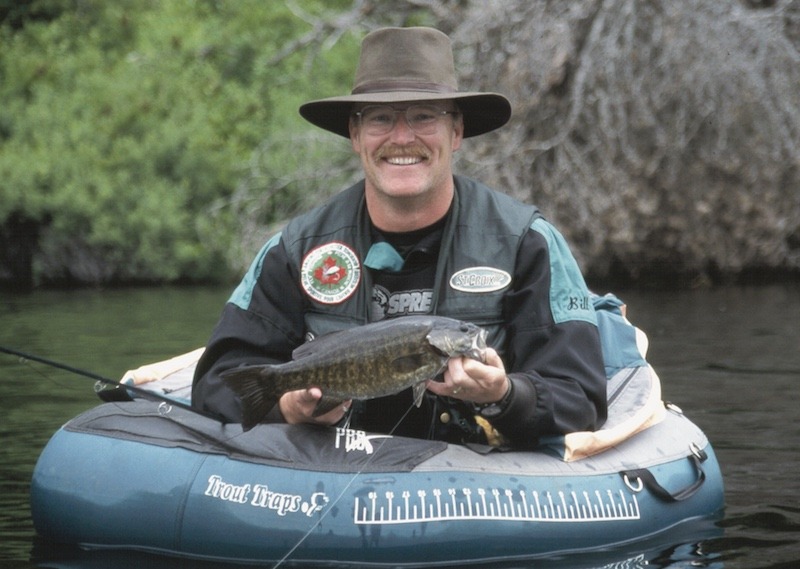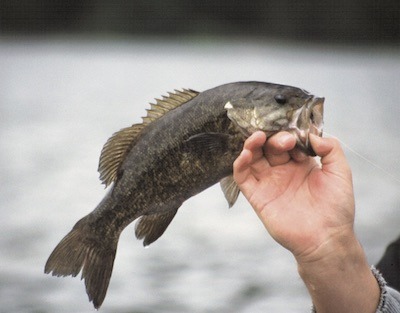
I’ve been fishing for the better part of 50 years and have caught almost every freshwater fish there is in Western Canada. I’ve fished pike, trout, Kokanee, char, grayling, sunfish, perch, catfish, suckers, squawfish, carp, and more, but I think the most interesting of the bunch might be the smallmouth bass. I’m not sure why, but smallies hold a tiny but special place in my heart. I think it is because of the timing of when I fish for them and how.
Researching about these fish turned up the following:
- Smallmouth bass (all bass actually) are not related to trout or char; in fact they are members of the sunfish family. Their Latin name is Micropterus dolomeui.
- They are a chunky fish, easily distinguished from other freshwater game fish by their quilled dorsal fin and lack of an adipose fin. In fact, they look more like a saltwater rockfish (rock cod) than anything else.
- Their colouring in stained water is very dark, and they aren’t very attractive when found in tea-coloured lakes. In clear waters however, these bad guys take on a more natural green and gold colouring and are actually quite pretty. You can easily distinguish a smallmouth from a largemouth by the red eye of the smallmouth.
- Bass spawn annually around the last week of May and can spawn in still water as well as moving water.
- They set up spawning “nests” on sand, gravel, or rocky bottoms within 150 meters of their previous year’s nest.
- When on their nests they become aggressive, and this makes them easy to catch.
- They have a lifespan of about 16 years and reach maturity at four years of age.
- They can attain a length of up to 69 cm (27 inches). Imagine a 69 cm bass! Woo-hoo!
- Bass prefer warmer water than trout and are most active in water temperatures between 16 to 24 degrees Celsius (60 to 75 degrees Fahrenheit).
- They are opportunistic predators and eat almost anything, but prefer crayfish and larger morsels like frogs, sculpins, and minnows.
- They like to school. Where you catch one, you’ll catch more.
- They stay near bottom and stick to structure such as downed logs and wharf pilings where they can hide in the shadows and dart out to attack unsuspecting passers-by.
- They are quite tasty, and there are lots of great recipes for cooking bass.
British Columbia on average isn’t all that hospitable for bass. Smallmouths prefer water temperatures around 21 degrees Celsius (70 Fahrenheit). The waters of B.C. are significantly colder than that for most of the year and often freeze in the winter—not much fun for a warm water fish. The result is that the bass are pretty lethargic creatures during the late autumn through mid-spring, and the best time to fish for them is mid-June through mid-October. This works out nicely for a lot of us, since the weather and temperatures between those dates are often warm and sunny and we can suntan while we fish.
Where to Start
As mentioned above, smallmouths prefer structured habitat. They notoriously linger around rocky outcroppings and pilings and like to skulk around under the wharfs and docks strewn along lakeshores. You can put this information to immediate use to increase your chances of success when fishing for them. Rocky sunken islands are a favourite place for these fish to hang out.
Fly Patterns to Use
Bass are not very picky when it comes to potential food, and your choice of flies can be as varied as you like, with a few rules to follow:
- Smallmouths seem to prefer active, swimmy patterns with lots of motion, so hard-bodied flies don’t produce as well.
- They also like large flies, much larger than you might use for trout of the same size. Marabou flies, like the Yellow Bellied Woolly Bugger or Clouser minnow in size #10 or #8, work exceptionally well.
- Patterns with a bit of gaudy colour seem to attract the bass’ attention better than the bland olives and blacks of the standard trout ties, so try adding a bit of colour to your trout patterns (hence the Yellow Bellied Woolly Bugger).
While I prefer angling for smallmouth with wet flies, others have good success on dries. The rule seems to remain consistent though: the bass prefer larger patterns with motion. Deer hair “poppers” are popular. Combination flies that use deer hair spun near the eye of the hook to float the fly and rabbit strip tied as a long tail that tips the fly vertical so that the rear half sinks, dangles like a worm, and swims in the water are very appetizing to the bass as well. It’s easy to select flies for bass, because the bass are predatory and will attack just about anything that looks like a meal, so let your imagination run wild when thinking up bass fly patterns.
Gear to Use
Smallmouth bass in B.C. range from six to 20 inches or larger. I have caught them up to 21 inches, although my average is about 15. They fight most like a brook trout, and the gear you use for brookies will do very well for smallies as well. Five- or six-weight fly rods and lines work great, although I prefer the lighter of the two. I like to start off fishing wet flies and fast-sink line to get to the bottom quickly. I also pack an extra spool strung with dry line in case I want to try a few floating flies.
Long casts and big runs are not in the realm of smallmouths and I find that a medium action rod serves me well when angling for these fish. It lets me relax more than my fast-action, distance-casting rods. Even better, though, is that the medium-action rods are more sensitive and allow me to feel more of the fish while I am playing it. It’s also a more forgiving rod should the fish hit hard, as bass can sometimes do, and avoids broken tippets.
Standard arbour, small-capacity reels with standard pawl drag systems work just fine. The bass do not make long runs and you need not worry about having a lot of backing at your disposal.
Technique
Fly fishing for smallmouth bass is easy. Because of their affinity for cover you need to locate obvious spots and get your fly right into them down near the bottom. It’s been my experience that casting is the only way to do this; trolling flies for bass doesn’t seem to work well at all. As I mentioned, in our local lakes one of the best places to locate these bad guys is under and around the boat docks and wharfs. Areas with rocky outcrops that drop off quickly to deeper water offer good cover for them as well, and I have had very good luck in such areas.
Short strip retrieves interspersed with slow hand twists every so often work well. Vary the speed of your retrieve and try to get the fly material to swim and undulate in the water. This motion really taunts gangs of bass. It’s sort of like strutting down in the bad part of town thumbing your nose at the hoods—they’re just bound to attack sooner or later.
Lakes to Try
Bass have been introduced in many lakes on Vancouver Island. Most of these lakes are easily accessible by paved road or good two-wheel drive gravel road.
Near Victoria, Elk, and Beaver Lakes on the Saanich Peninsula are well-known for producing nice bass. Further south in the Victoria and Colwood areas, Langford and Glen Lakes hold big bass, especially Langford. I witnessed a fellow pull a huge five-pound monster out a few years ago.
Moving up the island towards Mill Bay, Shawnigan Lake produces large smallmouth and is my favourite haunt for these fish. Up top on the Malahat sits Oliphant Lake, and it contains a ton of small-sized smallies. Just north of Duncan in Chemainus is Fuller Lake, and it contains large numbers of smaller bass. If you catch the ferry across the water from Crofton to Saltspring Island, St. Mary’s Lake and Cusheon Lake both produce great bass.
Even further north you arrive at Cedar and Yellow Point. Quennell Lake is there and is very well known for producing large bass. Continuing north you reach Nanaimo, and Westwood Lake there contains good numbers of average bass. If you continue north you can access Spider Lake, which holds smallmouth as well.
There are so many lakes on the southern half of Vancouver Island that hold smallmouth that it’s easy to pick one and have a very successful day. If you live here it’s a simple thing to make a morning, afternoon, or full day trip to fish for these little scrappers. If you are coming over for a visit from the mainland, just a little planning is all that is needed to enjoy a wonderful day or weekend of fishing and camping.
The majority of people who fish for bass release their catch. I’ve mentioned to a few that they should try frying one up for lunch or dinner and I get a strange, grimacing look from them. In truth, smallmouths are quite delicious and there are many tasty recipes available on the internet. Most involve a batter or coating of some sort, but the fish cooks up with a white meat similar to our coastal rockfish or rock cod.
If you have never tried fishing for bass, you should. It’s a hoot. The hot days of summer are great days to be on the water, and active bass make it even better. Get out and hook into a few.
2 Comments
Leave A Comment
Visit the Store
$25.47
$25.47
Featured Catch

Joel Unickow halibut (Photo: Rob Frawley Lucky Strike Sportfishing Tofino)








Long lake in Nanaimo also holds good size smallmouth
can u fish off shore